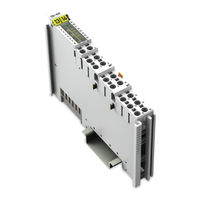WAGO 750-632/000-100 Manuals
Manuals and User Guides for WAGO 750-632/000-100. We have 1 WAGO 750-632/000-100 manual available for free PDF download: Manual
WAGO 750-632/000-100 Manual (152 pages)
Proportional Valve Module For WAGO-I/O-SYSTEM 750
Brand: WAGO
|
Category: Control Unit
|
Size: 7 MB
Table of Contents
-
-
-
View19
-
Connectors20
-
Device Data28
-
Power Supply28
-
Inputs28
-
Outputs29
-
Wiring30
-
Approvals31
-
-
-
7 Mounting
68 -
-
-
-
Undervoltage97
-
Wire Break98
-
11 Appendix
102-
Message102
-
Synchronization105
-
Data Exchange108
-
Channel Error113
-
General Errors115
-
Table121
-
Setpoint Value131
-
Actual Value131
-
-
List of Figures
147-
List of Tables149
-
Advertisement
Advertisement
